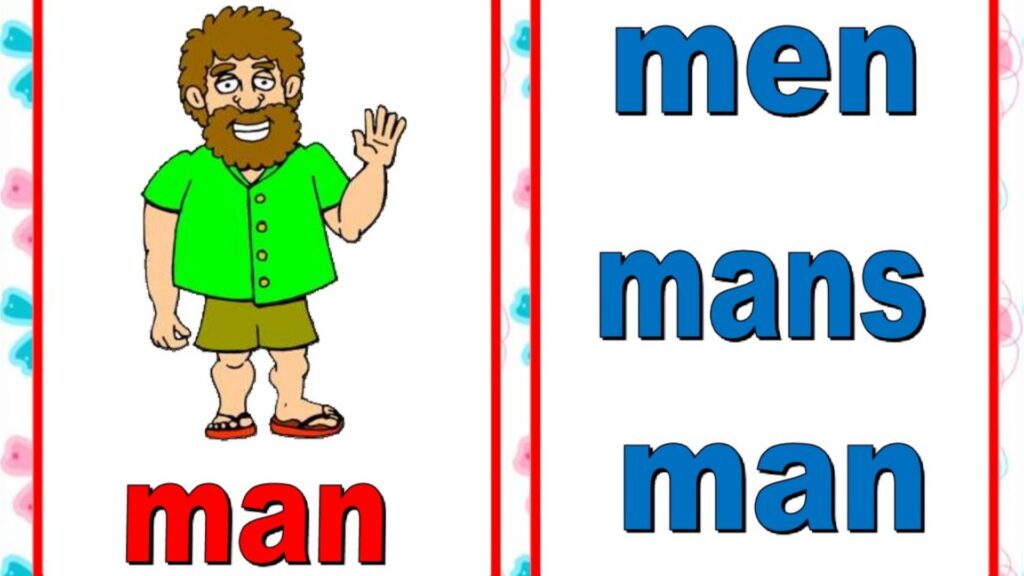Ever found yourself wondering, “Is it man or men?” You’re not alone. Whether you’re writing a school paper, drafting an email, or helping someone learn English, knowing the plural of man and how to use it correctly is key. In this guide, we’ll break down everything you need to know from grammar rules to real-life examples, even a quick worksheet at the end.
✅ Keyword + Intro Explanation

Let’s begin with the obvious: “Man” is singular. “Men” is plural. But there’s more to it than that. The word man belongs to a category of irregular plural nouns, meaning it doesn’t simply add an “-s” or “-es” like most English nouns.
So, if you’ve ever asked:
- What is the plural of man?
- Is men singular or plural?
- Why isn’t it “mans”?
You’re about to get answers that not only make sense but stick.
🤔 Simple Definition + Usage Overview
Man refers to one adult male human being, while men refers to more than one.
This is an example of an irregular plural transformation, specifically using a process known as i-mutation (or i-umlaut) from Old English.
| Singular | Plural |
|---|---|
| man | men |
📌 “Man” becomes “men” not “mans,” not “mens.” Those are incorrect.
🧠 Clear Rules & Patterns
Here’s how to know when to use man vs. men and how to keep your grammar on point.
✅ Use man when:
- Referring to one individual.
- The subject is singular and requires a singular verb.
Example:
The man walks to work every morning.
✅ Use men when:
- Referring to two or more individuals.
- The subject is plural and pairs with a plural verb.
Example:
The men were honored at the ceremony.
📋 Bulleted Rules with Do’s & Don’ts
✔ Do:
- Use “men” as the correct plural of “man.”
- Make sure your subject–verb agreement matches (e.g., “men are,” not “men is”).
- Check context don’t confuse “man” with mankind (which can be collective).
❌ Don’t:
- Say “mans” this is grammatically incorrect.
- Use “mens” this form does not exist in standard English.
- Write “a men” that’s mixing singular and plural.
✉️ Scenario Example 1: Email to a Manager
Subject: Correction Needed on Staff Bio Section
Hi Mr. Jenkins,
I noticed a small grammatical error in the staff directory. In the paragraph about the construction team, the sentence says, “Each men brings his own tools.”
It should read, “Each man brings his own tools.”
Just a heads-up! Let me know if you’d like me to update it.
Best,
Marianne
👉 This showcases a subject–verb agreement error and how singular vs. plural usage can alter grammatical correctness.
🧱 Scenario Example 2: Construction Site Description
The construction crew included ten men. Each man had a specific task from operating machinery to laying bricks. Despite the heat, the men worked efficiently and completed the job two days early.
This sentence smoothly transitions between singular and plural use of man/men, with subject-verb agreement:
- “Men worked…” (plural subject and verb)
- “Each man had…” (singular subject and verb)
🔁 Before/After Examples in Everyday & Formal Contexts
🏠 Everyday Use:
❌ That mans is funny.
✅ That man is funny.
🏢 Formal Use:
❌ The mens of the board were present.
✅ The men of the board were present.
🧩 Common Mistakes & Fixes
| Incorrect | Why It’s Wrong | Corrected Version |
|---|---|---|
| The mans are outside. | “Mans” isn’t a word. | The men are outside. |
| That men is tall. | Mixing plural subject with singular verb. | That man is tall. |
| I saw five mans at lunch. | Incorrect plural form. | I saw five men at lunch. |
| One of the men were late. | “One” is singular needs a singular verb. | One of the men was late. |
🔎 Quick Reference Table
| Term | Type | Usage Example |
|---|---|---|
| man | singular noun | “One man opened the door.” |
| men | irregular plural noun | “Several men lined up outside.” |
| mans | ❌ incorrect plural | Do not use nonstandard. |
| mens | ❌ incorrect plural | Do not use nonexistent form. |
📚 Linguistic Deep Dive (Optional, but Fun!)

The word “man” comes from Old English “mann”, originally meaning a human being (regardless of gender). Over time, it shifted to mean adult male. The plural “men” resulted from i-umlaut, a vowel change pattern in Germanic languages where the “a” sound became “e” to signal plurality just like goose → geese and tooth → teeth.
Other irregular examples include:
- Woman → women
- Foot → feet
- Mouse → mice
These are all examples of irregular plural noun transformations that defy the usual “add -s” rule.
📄 Plural Noun Worksheet (Downloadable or Copy-Paste Friendly)
✅ Worksheet: Practice with “man” and “men”
Part A: Fill in the blanks with “man” or “men”.
- The old ___ told us a story.
- Five ___ were fishing by the lake.
- One ___ can make a difference.
- All the ___ were wearing hard hats.
- A wise ___ once said, “Know thyself.”
Part B: Correct the sentence.
- The mans were running late. → ________________
- That men is very kind. → ________________
- Each men has a task. → ________________
Part C: Create sentences using the word:
- “man”
- “men”
🧠 Final Thoughts: Why Is the Plural of Man Not Mans

English is full of grammar irregularities, especially when it comes to pluralization. The difference between man and men is rooted in language evolution, not logic. It doesn’t follow the regular plural noun rule, and that’s why it’s so often misunderstood.
So next time someone asks, “Is man a regular noun?” you’ll know it’s not.
It’s an irregular plural form, and it’s one of many quirks that make English so fascinating.
Now you know how to use “man” and “men” like a pro. Print the worksheet, test yourself, or share it with someone learning English. And remember language doesn’t always play by the rules, but once you know the patterns, you’ve got the power. 💪

